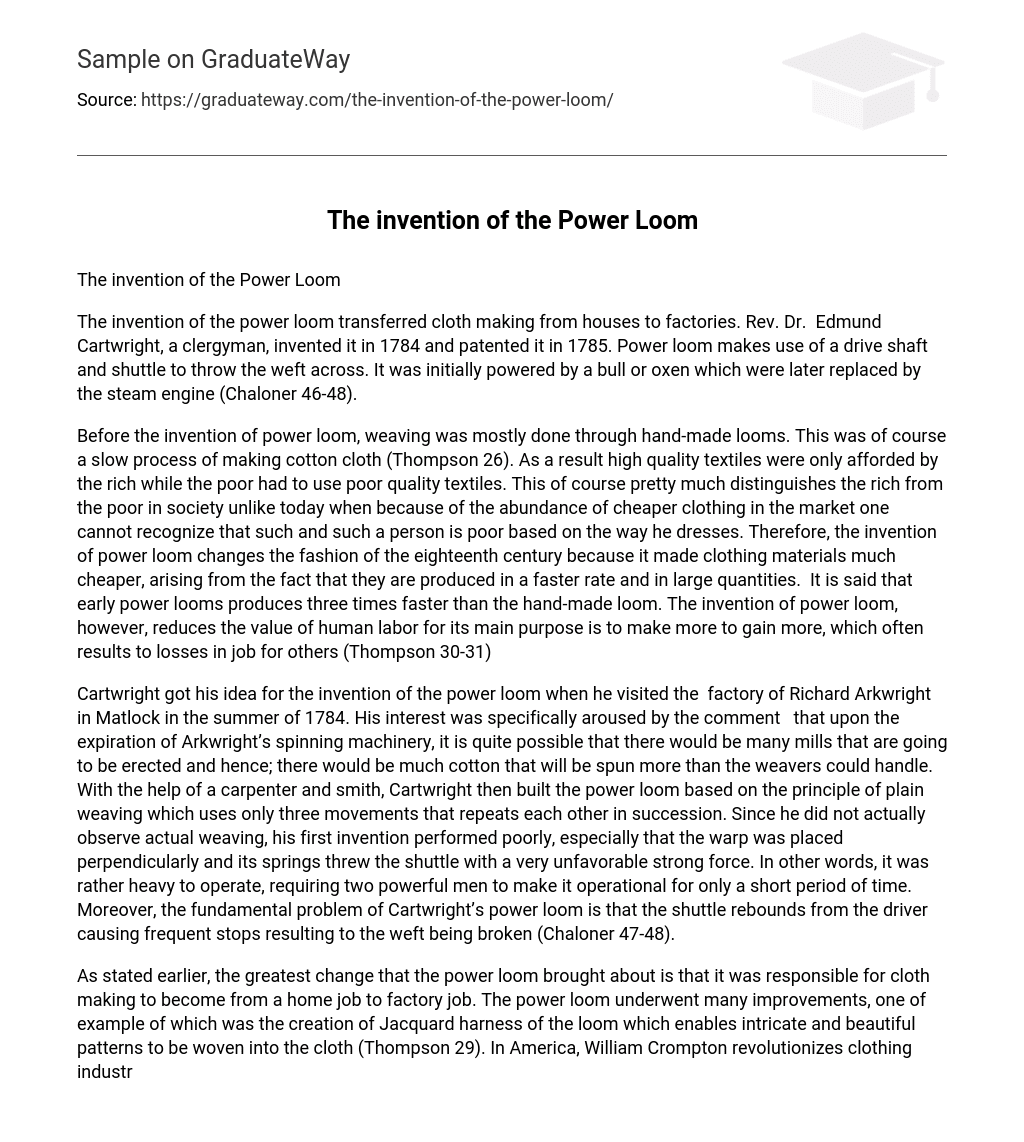The invention of the power loom transferred cloth making from houses to factories. Rev. Dr. Edmund Cartwright, a clergyman, invented it in 1784 and patented it in 1785. Power loom makes use of a drive shaft and shuttle to throw the weft across. It was initially powered by a bull or oxen which were later replaced by the steam engine (Chaloner 46-48).
Before the invention of power loom, weaving was mostly done through hand-made looms. This was of course a slow process of making cotton cloth (Thompson 26). As a result high quality textiles were only afforded by the rich while the poor had to use poor quality textiles. This of course pretty much distinguishes the rich from the poor in society unlike today when because of the abundance of cheaper clothing in the market one cannot recognize that such and such a person is poor based on the way he dresses. Therefore, the invention of power loom changes the fashion of the eighteenth century because it made clothing materials much cheaper, arising from the fact that they are produced in a faster rate and in large quantities. It is said that early power looms produces three times faster than the hand-made loom. The invention of power loom, however, reduces the value of human labor for its main purpose is to make more to gain more, which often results to losses in job for others (Thompson 30-31)
Cartwright got his idea for the invention of the power loom when he visited the factory of Richard Arkwright in Matlock in the summer of 1784. His interest was specifically aroused by the comment that upon the expiration of Arkwright’s spinning machinery, it is quite possible that there would be many mills that are going to be erected and hence; there would be much cotton that will be spun more than the weavers could handle. With the help of a carpenter and smith, Cartwright then built the power loom based on the principle of plain weaving which uses only three movements that repeats each other in succession. Since he did not actually observe actual weaving, his first invention performed poorly, especially that the warp was placed perpendicularly and its springs threw the shuttle with a very unfavorable strong force. In other words, it was rather heavy to operate, requiring two powerful men to make it operational for only a short period of time. Moreover, the fundamental problem of Cartwright’s power loom is that the shuttle rebounds from the driver causing frequent stops resulting to the weft being broken (Chaloner 47-48).
As stated earlier, the greatest change that the power loom brought about is that it was responsible for cloth making to become from a home job to factory job. The power loom underwent many improvements, one of example of which was the creation of Jacquard harness of the loom which enables intricate and beautiful patterns to be woven into the cloth (Thompson 29). In America, William Crompton revolutionizes clothing industry when he invented a power loom that was capable of weaving fancy fabrics in cotton and woolen materials. As the supply of cotton and woolen material becomes more and more abundant, the demand for more diverse clothing style and design emerges, resulting to the innovations in the cutting and printing equipments (Kidwell & Christman 67-69, 79). Subsequent improvements however were geared toward automation which is called perfected automatic loom ( courtesy of William Horrock in 1802) that aims to produce more durable fabrics and improves the quality of material from coarse to fine work and later on ,for producing a variety of materials like medium- and low-grade woolens ( cashmere, satinets, jeans and flannels)(Thompson 30). However, although I recognize that clothing material from power looms are of good quality, the hand made ones are still the best in terms of quality and durability simply because they are individually made, so that each piece was given equal and thoughtful attention.
The power loom, therefore, is responsible for making the cotton and woolen clothing materials (and subsequent material developments) readily available to all walks of life, changing the fashion of the eighteenth century. Improvements in power looms still continue although the trend is toward more automation. Moreover, power loom also encourages the innovation and invention of other technology, such as the cutter and printing machine to cope up with the ever rising demand for a variety of clothing style and design.
Works Cited
Chaloner, William. People and industries. New York: Routledge, 1963.
Kidwell, Claudia B. and Margaret C. Christman. Suiting Everyone: the Democratization of Clothing in America. Washington, DC: Smithsonian Institution Press, 1974.
Thompson, Eliza B. Cotton and Linen. Read Books, 2008.





